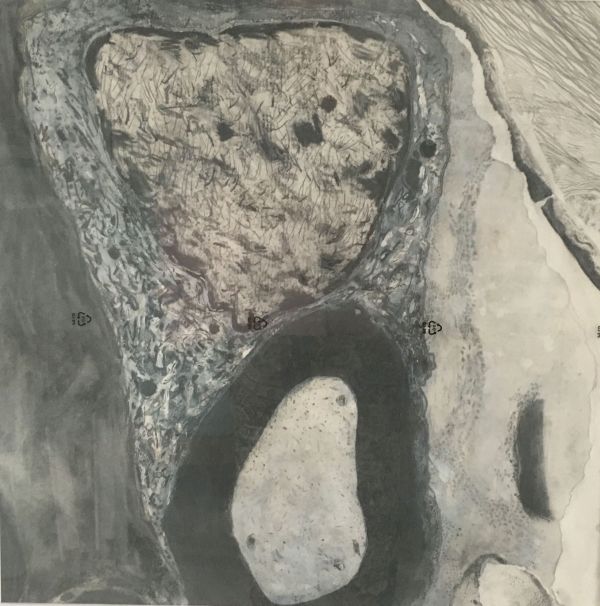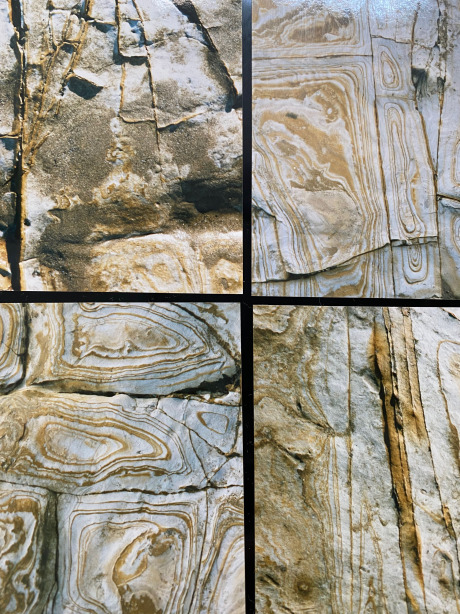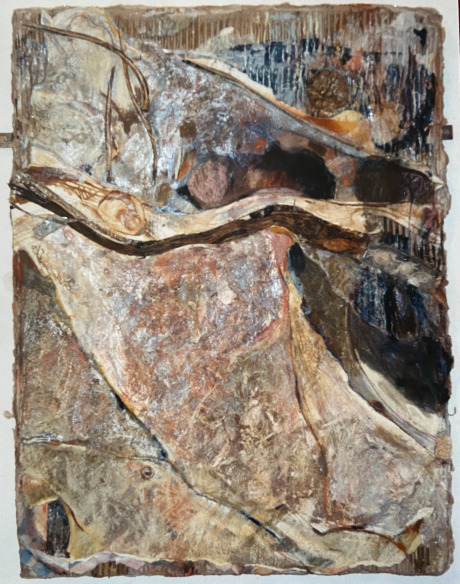michelenobleartist.co.uk
MA in Art Design at Humberside University
I applied to study the MA in Art Design at Humberside University. I began making large drawings of cellular biology slides. Except for these two examples, I reused these in later work for collage. I also made a series of rock pool drawings using oil pastels and a series of silk screen prints helped by my husband who was a painter and printmaker. They were never completed as husband died suddenly in August 1989 but I have made use of them in recent work. I returned to the MA to complete my course in 1993.



Abstract Landscape Silk Screen Print 1989 NFS
Island graphite, paint,collage, ink 1989 65 x 65 cm
Price inc frame: £
Untitled graphite, paint, collage, ink 1989
19.3in x 19.3in
Price inc frame: £

Rock Pool One Oil Pastel 1989
35cm x 29cm / 13.75in x 11.35in
Price:

Rock Pool Two Oil Pastel 1989
35cm x 29cm / 13.75in x 11.35in
Price:

Rock Pool Three Oil Pastel 1989
35cm x 29cm / 13.75in x 11.35in
Price:
MA in Art Design at Humberside University
The first art I made in my new beginning was incoherent. I was unsure how to continue. The work I had made before seemed pointless in the face of death. I discovered a series of striated rocks and pools near Scarborough Spa. They were exciting like maps to an unknown country. I became interested in geology and the way rock and sand are formed. The constant recycling and transformation. The fragility of rockpool life exposed to sea and weather. It resonated with my loss. I made drawings using sticks and ink and graphite. These developed into the Song Line Series, using layered corrugated card. This allowed me to embed objects like fossils in rock and opened meanings into symbolism.




MA Songline series 1993
It is thanks to my mentor’s suggestion, to glue layers of corrugated card together, that I began to see a path. It immediately made the surface three dimensional. I recycled sections of the initial large drawings, to make surfaces to draw on and carved out channels to embed objects like shells and pebbles. The corrugated card equated to the strata of cliffs that enclose fossils, to layers of experience. These images became The Song Line Series.




MA Memory, Transformation and Metamorphosis Series
I used papier mâché from all the paper that came into the house over a couple of months, like envelopes, wrapping paper etc, the ephemera of daily life. The shredding required to make paper pulp, satisfied a need to ritualise and the raw material incorporated both past and present, also an acknowledgement of the millions of dead sea creatures that had formed the sand and rock in the first place. It seemed a satisfactory metaphorical solution, it was light and could be made rocklike. Scraps of glossy magazines in the mix, left traces of colour like fragments of shells, wisps of memory. I built cairns for the dead from towers of pebbles and the dried seaweed became twisted into beautiful shapes echoing bone. I photocopied actual shells, crabs, sea urchins on film, to resemble water. Finally, I displayed these objects within plastic boxes so everything was visible. These were suspended by rope and fishhooks space so both sides could be seen but only one side at once – high and low tide.




The only thing that went wrong was the daytime Summer temperatures made the Gallery into an oven. It sprang the glued sides of the boxes and they all had had to be taken down and rejoined.



The writing gave me a voice to disagree with some of the views put forward on the course and not only explain the thinking behind the artwork but also what had influenced me through my life. It’s a chance few artists are given. Usually art work has to stand alone, open to viewer interpretation with perhaps some help from the title. It was both an enjoyable and educational experience. My fears about writing it were needless, I had so much material I could have written a book, making it difficult to edit down to the 8000-word count specified!